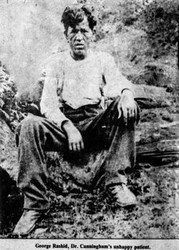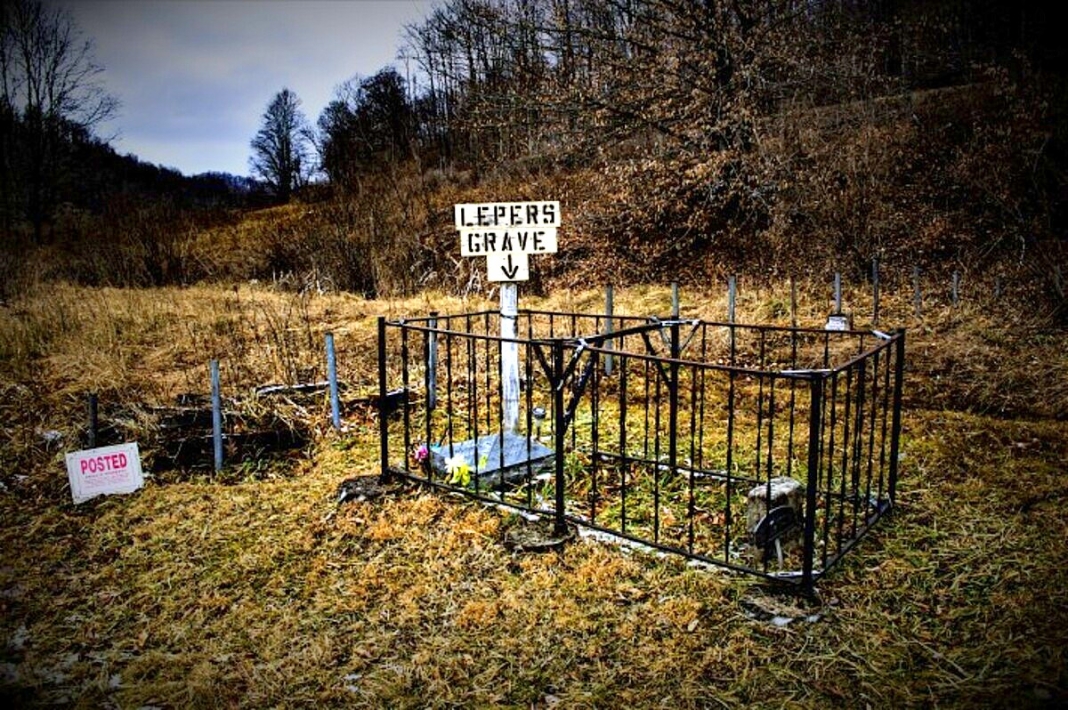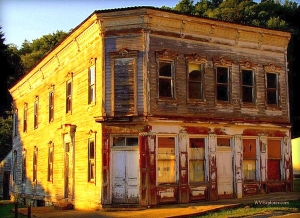PICKENS, W.Va. — In a remote section of the Allegheny Mountains of northern West Virginia lies a solitary grave, marked only by two weathered stones. It belongs to an immigrant who died in isolation, far from his homeland. His story opens a haunting window into a forgotten chapter of American history, where public health, immigration, and small-town fear tragically intersected.
From Syria to America, hope in hand
George Rashid was born in 1867 in what was then known broadly as Syria, now in modern‑day Lebanon. In 1902, amid waves of eastern catholic, or Maronite, emigration, he crossed the Atlantic Ocean bound for the United States. He and fellow immigrants landed in Waterville, Maine. There, Rashid found work as a section hand laying railroad track. In 1903, his wife joined him.

For four years, he worked on the railroad lines. But by early 1906, he began to notice troubling symptoms—numbness, lesions on his arms and legs, and loss of sensation. These were hallmarks of leprosy. He concealed the signs by wearing gloves and long sleeves—even on sweltering summer days in Maine—hoping coworkers would not suspect his condition. Yet curiosity grew. Rumors circulated. Feeling his safety threatened, he and his wife left Maine to seek refuge in West Virginia.
Leprosy, also known as Hansen's disease, is a chronic infectious disease caused mainly by a type of bacteria called Mycobacterium leprae. The disease affects the skin, the peripheral nerves, the mucosa of the upper respiratory tract, and the eyes. Apart from the physical deformity, people affected by leprosy also face stigmatization and discrimination. However, leprosy today is curable, and treatment in the early stages can prevent disability.
By early June 1906, the Rashids had arrived in Elkins, seeking support from his brother, Charley Rashid, who ran a store dealing in rugs, tapestries, and linens. Though he had kept his condition hidden for months, Charley recognized the danger and, after three weeks, took him to Dr. W. W. “Ben” Golden, whose medical expertise swiftly led to a diagnosis of leprosy.
News of the diagnosis spread rapidly. Mass hysteria erupted across Elkins and the surrounding areas. County and state public health officials were alerted, and soon George was informed that he could not stay. Public sentiment turned hostile. In desperation, believing that immersion in the Jordan River might cure him, Rashid boarded a pre‑dawn eastbound coal train from Elkins, attempting to return home to Syria. But railroad authorities intercepted him in Cumberland, Maryland.
According to late historian L. Wayne Sheets, Rashid was desperate not only to live, but to escape the growing hostilities surrounding him.
"Knowing that he had leprosy from having been exposed to it in Syria, Rashid caught a pre-dawn eastbound coal train out of Elkins in a desperate attempt to return home," Sheets wrote, "believing that if he could swim in the Jordan River, he would be healed."
Exile to the end of the line
Because Rashid had been found aboard a Baltimore & Ohio Railway train, the company assumed responsibility for him. They transported him to Pickens, West Virginia, the final terminal on the line and one of its most remote outposts. There, effectively, he became a prisoner of relocation—a human quarantine imposed by both public health policy and railroad jurisdiction.
Pickens was then a tiny settlement isolated in the mountains. It had few residents, limited services, and no local medical infrastructure. In fact, it remains small and today is home to only 41 people as of the 2020 census.
Enter Dr. James L. Cunningham, the town physician at Pickens. A respected medical practitioner, he was later the nation’s oldest living physician until his death in the 1960s. He took responsibility for Rashid’s care. To isolate him, the railroad had erected simple quarters for Rashid—a canvas tent on a hill north of town, across the Buckhannon River. Cunningham began providing medical care, administering salves for the skin lesions, and attending to his general condition.
Dr. James Cunningham: humanity in the face of fear
Within days, Rashid began to complain of chest pains. A thorough exam revealed mitral stenosis, a severe and irreversible heart condition. Cunningham realized that while leprosy would progress slowly, George’s heart disease posed an immediate threat.
As news of Rashid’s habitation in the town spread, alarm mounted. Some residents reported that they had witnessed him bathing in the Buckhannon River—the local drinking water source—and demanded that he be removed or even killed, citing biblical imagery of leprosy and uncleanliness. Fueled by fear and ignorance, town leaders called for action.
Cunningham, however, intervened and sought legal protection from the governor, publicly arguing that Rashid posed no threat, demonstrating exemplary medical and moral leadership in the face of prejudice. On more than one occasion, confronting an angry mob, Cunningham brandished his pistol to ward off men demanding Rashid's removal. His efforts made national headlines as an unusual case of compassionate care for a long-standing disease.
Daily life at the end of the line
Life in Pickens for Rashid was one of rigid quarantine. Cunningham, and later the railroad, tried to make his final months bearable. The B&O sent supplies, including Turkish cigars and occasional candy dropped from passing trains. His wife was permitted weekend visits—traveling by B&O—to see her husband, a rare human connection amid enforced isolation.
A caretaker, Mrs. Mary Warner, was hired for 33 cents per day to bring meals served on wooden trays that were burned after each use to avoid contagion. She later recalled his favorites—chicken, apples, and apple pie.
Rashid warned curious children away from his tent by shouting “unclean” and showing them his hands when necessary, avoiding drawing attention, though he grudgingly allowed photographers inside in exchange for food or small gifts.
As winter closed in, the canvas tent proved insufficient. Cunningham arranged for a small shanty, closer to the tracks and offering more protection from the elements. However, this move enraged locals even more. At one heated confrontation, townspeople demanded again to have George removed, only to be turned back by the doctor with his pistol, standing his ground for decency and medical principle.
Death and burial of the Pickens Leper
On October 11, after approximately 100 days under Cunningham’s care, Rashid died in his sleep. Contrary to popular belief, Cunningham officially ruled his death as resulting from a heart attack rather than leprosy.
Undertakers from nearby Huttonsville were summoned but refused to touch the body, fearful of contagion. The corpse lay near his shanty for hours. Only at night did the undertakers return. They placed Rashid in a coffin and buried him a few feet from the railroad tracks where he had lived and died.
In accordance with the medical customs of the time, his body and belongings were burned, and the coffin was covered with lime, standard practice for leprosy patients, even though in this case his death was due to heart disease. The gravesite was marked simply by two stones at each end of the mound.
Legacy of the Leper’s Grave
For decades, the grave remained a modest marker, but in 1986, the Pickens Improvement and Historical Society placed a proper headstone and protective fence at the site. Today, it is known locally as “The Leper’s Grave” and is one of the only known burial sites of a leper in West Virginia.
The memory of George Rashid resides not just in the stones upon his grave, but in a broader recognition of compassion over panic and humanity over fear. A documentary film produced in recent years, "George Rashid: The Leper of Pickens," invited fresh reflection on his life and on the tenacious care offered by Cunningham in a time of medical isolation and small‑town prejudice.
Public health, anti‑discrimination
Rashid’s story is often cited today by scholars and activists as an early case of discrimination due to disease, intersecting with immigrant status and religious difference. A professor at Marshall University, involved in the film’s production, highlighted how George’s situation intersects with contemporary discussions about stigma and the historic mishandling of disease outbreaks.
It’s worth remembering that leprosy was deeply misunderstood in early 1900s America—associated with biblical curses, medieval hygiene fears, and sweeping quarantine laws. George’s case illustrates the human cost of ignorance: forced exile, public scrutiny, and ultimate solitude.
A life lost: the Pickens Leper
Rashid came to America seeking a new opportunity. He worked diligently, married, built a life, and yet was ultimately undone by disease and fear. His last months were ones of enforced isolation, struggling to leave a legacy amid ugliness. But compassion, embodied by Cunningham’s resolute defense and medical care, offered dignity where others offered stones and condemnation. The people of the community were accused by many of committing the Sin of Sodom, of the inhospitable treatment of strangers, the refusal to provide help to the poor and needy.
Today, the small fenced grave in Pickens draws few visitors, but for those who do come, it raises questions. How should communities respond to the unfamiliar and the feared? Who speaks for the vulnerable when panic rises? And how can the memory of one man’s suffering shape more humane public policy and social care?
As sure as the mountains rise above the Buckhannon River, the memory of George Rashid, the “Pickens Leper,” endures. His story is a stark reminder that compassion can only take root if fear is confronted and that even in remote corners, the human spirit can demand dignity in life and in death.
Map showing grave of "Pickens Leper"
Sign up to receive a FREE copy of West Virginia Explorer Magazine in your email weekly. Sign me up!





An amazing story. I have lived in West Virginia all of my life and have been both amazed at the passion of the friends and family who live here, and the powerful ignorance of prejudice that fills many. Hopefully one of my personal beliefs, (that we are not completely gone from this world until no one remembers us), can give comfort and long existence to Dr. Cunningham and Mr. Rashid. Thank you for remembering them and telling us about their history.
This is the best piece I have seen from you in quite some time, David! Great Work!
Roger Hicks
Informative and heartbreaking. Thank you.
Another great story. Thanks David
Well done! Excellent retelling.
The WV I grew up in is one of Dr. Cunningham's world & I long for it to return.
A great article which I’m familiar vaguely with. I love all your articles David but this one is probably the best only because
I lived in Pickens the first year of my life and having grandparents and various relatives there-Pickens was my second home away from home.
The story about the leopard male was one of sadness. I can understand the fear of not knowing how this could affect each
individual but Dr Cunningham was ok being around this poor man. Everyone praised Dr Cunningham for his knowledge.
Mr Rashid lived a very lonely life and in fear of what would happen next. God rest his soul. My family returned to Pickens for various occasions throughout the years and we always drove by and paid our respects to this individual. It was very sad to think how this gentleman had to live his life out basically by himself.
Thanks David for any great story-this one just touched close to home.
Wonder if the Rashids that live in Charleston are descendants of his?
Wonderful article but so sad. Thank you for sharing.
Excellent story. I love your magazine! Keep up the good work.
I just saw the article and read it before starting my day. Not so amazing even with COVID people act like jerks and won't recognize there behavior until it's to late and sometimes want to be awarded. Unclean . I won't forget that.